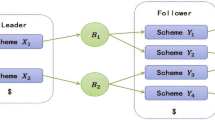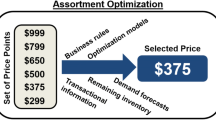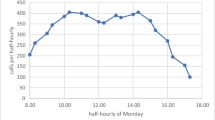Abstract
We consider scheduling a shared server in a two-class, make-to-stock, closed queueing network. We include server switching costs and lost sales costs (equivalently, server starvation penalties) for lost jobs. If the switching costs are zero, the optimal policy has a monotonic threshold type of switching curve provided that the service times are identical. For completely symmetric systems without set-ups, it is optimal to serve the longer queue. Using simple analytical models as approximations, we derive a heuristic scheduling policy. Numerical results demonstrate the effectiveness of our heuristic, which is typically within 10% of optimal. We also develop and test a heuristic policy for a model in which the shared resource is part of a series network under a CONWIP release policy.
Similar content being viewed by others
References
D.P. Bertsekas, Dynamic Programming: Deterministic and Stochastic Models (Prentice-Hall, Englewood Cliffs, NJ, 1987).
D. Bertsimas and J. Niño-Mora, Conservation laws, extended polymatroids and mult-armed bandit problems; a unified approach to indexable systems, Math. Oper. Res. 21 (1996) 257–306.
M. Elhafsi and S. Bai, Optimal and near optimal control of a two-part-type stochastic manufacturing system with dynamic set-ups, Preprint (1996).
A. Federgruen and Z. Katalan, Determining production schedules under base-stock policies in single facility multi-item production systems, preprint (1995).
A. Federgruen and Z. Katalan, The stochastic economic lot scheduling problem: Cyclical base-stock policies with idle times, Managm. Sci. 42(6) (1996) 783–796.
J.C. Gittins, Multi-Armed Bandit Allocation Indices (Wiley, New York, 1989).
A.Y. Ha, Optimal dynamic scheduling policy for a make-to-stock production system, Oper. Res. 45 (1997) 42–53.
W.J. Hopp and M.L. Spearman, Factory Physics: Foundations of Manufacturing Management (Irwin, Chicago, 1996).
E. Kim and M.P. Van Oyen, Beyond the cμ rule: Dynamic scheduling of a two-class loss queue, Math. Methods Oper. Res. 48(1) (1998).
E. Kim, M.P. Van Oyen and M. Rieders, General dynamic programming algorithms applied to polling systems, Working paper, Northwestern University, Evanston, IL (1996).
G.P. Klimov, Time sharing service systems I, Theory Probab. Appl. 19 (1974) 532–551.
H. Levy and M. Sidi, Polling systems: applications, modelling, and optimization, IEEE Trans. Commun. 38 (1990) 1750–1760.
D.M. Markowitz and L. Wein, Heavy traffic analysis of dynamic cyclic policies: A unified treatment of the single machine scheduling problem, Working paper 3925–96-MSA, MIT Sloan School of Management, Cambridge (1996).
J. Qiu and R. Loulou, Multiproduct production/inventory control under random demands, IEEE Trans. Automat. Control 40(2) (1995) 350–356.
S.M. Ross, Introduction to Stochastic Dynamic Programming (Academic Press, New York, 1983).
S.M. Ross, Stochastic Processes (Wiley, New York, 1983).
M.L. Spearman, D.L. Woodruff and W.J. Hopp, CONWIP: A pull alternatives to KANBAN, Internat. J. Production Res. 28(5) (1989) 879–894.
M.L. Spearman and M.A. Zazanis, Push and pull production systems: Issues and comparisons, Oper. Res. 40(3) (1992) 521–532.
H. Takagi, Queueing analysis of polling models: Progress in 1990–1993, in: Frontiers in Queueing: Models, Methods and Problems, ed. J.H. Dshalalow (CRC Press, 1994).
M.H. Veatch and L.M. Wein, Optimal control of a two-station tandem production/inventory system, Oper. Res. 42(2) (1994) 337–350.
M.H. Veatch and L.M. Wein, Scheduling a make-to-stock queue: Index policies and hedging points, Oper. Res. 44(4) (1996) 634–647.
L.M. Wein, Dynamic scheduling of a multiclass make-to-stock queue, Oper. Res. 40(4) (1992) 724–735.
P. Whittle, Restless bandits: activity allocation in a changing world, in: A Celebration of Applied Probability, ed. J. Gani, J. Appl. Probab. 25A (1988) 287–298.
Y. Zheng and P. Zipkin, A queueing model to analyze the value of centralized inventory information, Oper. Res. 38(2) (1990) 296–307.
Author information
Authors and Affiliations
Rights and permissions
About this article
Cite this article
Kim, E., Van Oyen, M.P. Dynamic scheduling to minimize lost sales subject to set-up costs. Queueing Systems 29, 193–229 (1998). https://doi.org/10.1023/A:1019136231100
Issue Date:
DOI: https://doi.org/10.1023/A:1019136231100




